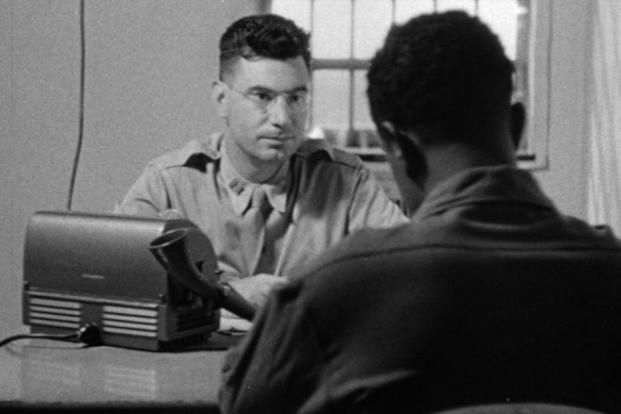Legendary Hollywood director (The Maltese Falcon & The Treasure of the Sierra Madre) and actor (Chinatown) John Huston served as a Signal Corps lieutenant during World War II, making documentaries to support the war effort. Olive Films has collected the four films in the new Blu-ray Let There Be Light, which includes Winning Your Wings, Report from the Aleutians, San Pietro and Let There Be Light. The disc also includes the documentary John Huston's Wartime Documentaries: An Introduction from filmmaker Bret Wood and the bonus features San Pietro: Raw Camera Footage and the Pentagon documentary Shades of Gray.
Most of these titles are streaming online in questionable quality. Olive, which does a great job restoring and reissuing titles overlooked by the big studios, has done their best to clean up these films but the original elements are either lost or have been allowed to degrade over the years. These are the best quality versions of these films available but don't go in expecting spotless prints. Wood's half-hour introductory documentary does a great job of putting the films and Huston's military career in context, hitting all the important moments details in Mark Harris' excellent 2014 book Five Came Back, which covered the WWII military careers of Hollywood directors John Ford, Frank Capra, William Wyler, George Stephens and Huston.
Winning Your Wings stands out as an airman recruitment film starring Jimmy Stewart. Huston wasn't credited with directing the film and it fits squarely into the tradition of upbeat WWII propaganda. The 18-minute picture pushes the honor, prestige and girls that airmen can expect but never mentions the danger to life and limb.
Report from the Aleutians is Huston's technicolor account of the defense of the Alaskan islands from Japanese attack in 1942. The 44-minute film highlights the boredom of day-to-day life in a remote outpost, including scenes of men digging latrines, having meals, attending mail call and standing around smoking. The monotony is punctuated by a pilot's crash and funeral. The Army didn't much like Huston's perspective but he eventually got to keep all his scenes intact. The film was released in 1943 and wont the Academy Award for Best Documentary Short. Strangely, that success didn't ensure the film's survival and even the restored version of the film is difficult to watch, with washed-out color and fuzzy images. Still, it's an important document of American forces stationed in one of those locales that never seem to get mentioned in books and films about the war.

The Battle of San Pietro is a powerful work that portrays the Battle of San Pietro Infine near Naples. Huston was attached to the U.S. Army’s 143rd Regiment of the 36th Division and his film purports to capture them as they fought their way through the country. The film generated controversy at the time because Huston showed dead soldiers in detail. Many of the brass wanted to suppress the film, fearing that it would damage morale and Huston was accused of being anti-war. The director's response was that he should be shot if he was ever caught making a pro-war film. Cooler heads prevailed and it was decided that the realism in San Pietro might cause new recruits to take their training more seriously.
The truth later emerged: there was no way the Army was going to allow Huston to put himself and his crew into the thick of war. The battle scenes in the film were reenactments and this disk includes a half-hour of raw camera footage that shows how Huston and his crew recreated the battle scenes much the same way they would've made a feature film. The recreations display an undeniable power, in no small part because soldiers fresh from battle are reliving the moment just hours or days later. Most powerful and controversial is Huston's last film for the Army.
Let There Be Light was suppressed for over 35 years because the brass didn't want Americans to see the director's work from New York's Edgewood State Hospital, which was treating veterans with "battle fatigue" and "nervous conditions" related to combat. Finally shown at the 1981 Cannes Film Festival, the work not only gave an early and unflinching look at PTSD, but it portrayed how well the hospital's treatment worked for most of its patients. The government was struggling to find jobs for returning vets and anything that portrayed fighting men as unstable or unreliable or even "dangerous" was seen as a detriment. The army remade Huston's film as Shades of Gray, which featured reenactments of the symptoms and treatments at the hospital. The acting and writing was so poor that the film was useless, but Shades of Gray remained the Army's definitive statement on PTSD for decades.

You can pick up a Blu-ray for around $17 online. There's also a DVD if you need one. Somehow, these films are both the Army's official version of the war and highly individual and subversive documents at the same time.




